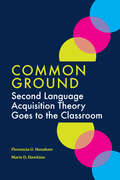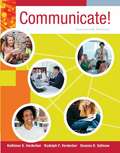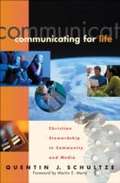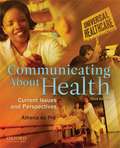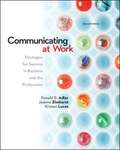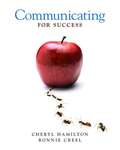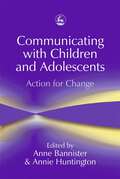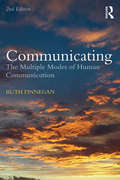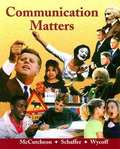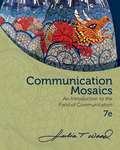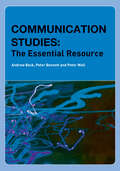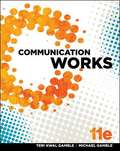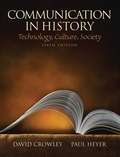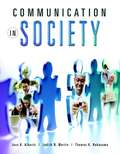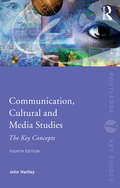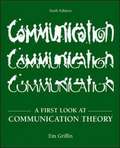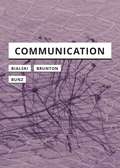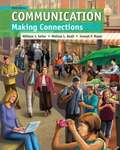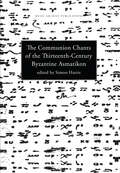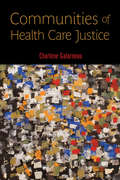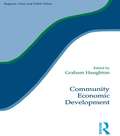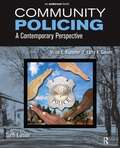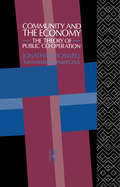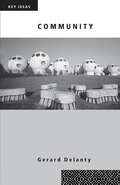- Table View
- List View
Common Ground: Second Language Acquisition Theory Goes to the Classroom
by Florencia G. Henshaw Maris D. Hawkins&“Common Ground is accessible to teachers at all levels yet firmly rooted in current questions of second language acquisition (SLA). One of its primary strengths is the authors themselves, both of whom are accomplished language teachers who understand the challenges and opportunities in communication-focused language teaching. Their experience, expertise, insight, and enthusiasm for language teaching translate into a book that is refreshingly practical for teachers, especially teachers who are striving to break from traditional drills commonly presented in textbooks. I hope this book finds its way into the hands of every language teacher who is looking for concrete examples of how SLA principles meet the realities of the classroom."—Stacey Margarita Johnson, Vanderbilt University
Communicate! (Fourteenth Edition)
by Rudolph F. Verderber Kathleen S. Verderber Deanna D. SellnowNow in its 14th edition, this ground-breaking, market-leading fundamentals of human communication text helps readers improve their communication competency by becoming proficient in using theory and research-grounded communication skills. Praised for its clear and concise writing style, this new edition includes increased coverage of how technology and social media are changing communication practices and offers guidelines for best practice. Lively contemporary examples and sample speeches ground theory, increase comprehension, and help readers become skillful communicators. COMMUNICATE! engages students in active learning through theory, application and skill-building exercises including speech action step activities that guide students through the speech preparation process. The role of ethics in communication is integrated throughout the text, and students can also apply ethical principles to case situations.
Communicating For Life: Christian Stewardship In Community And Media (Renewedminds)
by Martin E. Marty Quentin J. SchultzeWHO WOULD EVER HAVE THOUGHT to combine the words communicating and stewardship? I would not have, and I have not seen such a combination before. But Quentin Schultze would, and did, and the product of his juxtaposition of the two concepts is in your hands. And you are in for some refreshing surprises.
Communicating about Health: Current Issues and Perspectives (3rd edition)
by Athena Du PréThe leading text in its market, Communicating About Health: Current Issues and Perspectives, Third Edition, provides a more far-reaching approach than any other health communication text. Written by Athena du Pré--an experienced researcher and noted scholar--the book offers an excellent balance of theory and practice; research and pedagogy; coverage of patient/caregiver issues; and material on the current, historical, and philosophical backgrounds of communication in health care. Now in its third edition, this highly engaging text is more accessible than ever to students. It integrates many more real-life examples and case studies and also builds upon the previous editions' coverage of diversity, featuring new material on cultures and health systems within the U. S. and abroad. A brand-new chapter, "Public Health Crises and Health Care Reform" (Chapter 12), addresses timely concerns about modern health care. In addition, the third edition incorporates enhanced pedagogical features and new supplemental resources, including: *Career Opportunity boxes showcasing more than one hundred careers related to health communication and links to job listings and further information *Can You Guess ?boxes challenging students to consider such questions as "Which state has the highest percentage of uninsured residents?" and "In which country do people have the longest life expectancy on earth?" *Instructor's Manual(available both in print and online at www.oup.com/us/dupre) featuring sample syllabi, test questions, class activities, and more An ideal combination of communication theory and practical advice, Communicating About Health, Third Edition, is designed for undergraduate and graduate courses in health communication, health promotions and campaigns, and public health. It is also an indispensable resource for readers looking to improve their communication abilities in the health care field.
Communicating at Work: Strategies For Success in Business and the Professions (11th Edition)
by Ronald B. Adler Jeanne Marquardt Elmhorst Kristen LucasThe 11th edition of Communicating at Work enhances the strategic approach, real-world practicality, and reader-friendly voice that have made this text the market leader for three decades. On every page, students learn how to communicate in ways that enhance their own career success and help their organization operate effectively. This edition retains the hallmark features that have been praised by faculty and students--a strong emphasis on ethical communication and cultural diversity, discussions of evolving communication technologies, and self-assessment tools--while incorporating important updates and ground-breaking digital teaching and learning tools to help students better connect to the course material and apply it to real world business situations.
Communicating for Success
by Cheryl M. Hamilton Bonnie CreelThis book focuses on the key communication competencies recommended by the National Communication Association. Introduced at the beginning of each chapter and integrated throughout the book, these learning outcomes help focus readers as they study the theory and skills needed to become better, more effective communicators. Well-written with interesting examples and a vibrant and engaging design, the book covers all the expected topics in an introductory course with a special appendix on interviewing. Each chapter begins with scenarios to which a reader can relate and then solve as they learn about the concepts discussed in each chapter. A concentrated focus on careers in communication, highlighted in a two-page spread near the end of each chapter, brings home the relevance of communication within the real world and helps the reader learn more about how studying communication can help them throughout their lives. Additional emphasis on topics such as ethics, culture, gender, and technology can be found throughout the book.
Communicating with Children and Adolescents: Action for Change
by Sue Jennings Kate Kirk Mario Cossa Annie Huntington Anne BannisterAt a time when expectations and assumptions about the delivery of services to children and adolescents are being reconfigured - for example, around the rights of children and adolescents as young citizens - adults are seeking to ensure that they deliver services in creative and empowering ways, ensuring that the opinions of young people are actively solicited and encouraged. Action methods - communication methods using the body as well as speech - provide non-threatening ways of communicating which can be understood by children of all ages and from many cultures. This book places action methods in a theoretical, technical and political framework and documents examples of good practice. Discussion of the application of action methods to work with young people focuses on differing issues and populations, for example children and adolescents who face life-threatening illnesses, or those involved in peer counselling in schools. Contributions from several different countries emphasise the wide potential of action methods for use with young people. This book provides a comprehensive and wide-ranging resource for those interested in exploring and understanding why action methods are particularly useful when working with young people.
Communicating: The Multiple Modes of Human Communication
by Ruth FinneganMany accounts of human communication suggest that we are limited to communicating through words, visual images, the mass media and by digital means. This perspective underestimates the multisensory qualities of much of our human interconnecting and the multiple sounds, touches, sights and material objects which humans use so creatively to interconnect both nearby and across space and time. Ruth Finnegan brings together research from linguistic and sensory anthropology, alternative approaches to 'material culture' and 'the body', non-verbal communication, cultural studies, computer-mediated communication, and illuminating work on animal communication. Examples from both western and non-western cultures together with plentiful illustrations enrich and deepen the analysis. The book uncovers the amazing array of sounds, sights, smells, gestures, looks, movements, touches and material objects which humans use so creatively to interconnect both nearby and across space and time - resources consistently underestimated in those western ideologies that prioritise 'rationality' and referential language. Focussing on embodied and material processes, and on practice rather than text, this comparative analysis challenges the underlying cognitive and word-centred model common to many approaches to communication. The second edition of Communicating includes a new introduction, updates to take account of recent work, an additional chapter covering ethereal non-verbal non-bodily communicating such as telepathy and dreams, fresh illustrations, a new conclusion and updated bibliography. This authoritative but accessible book is an essential transdisciplinary overview for researchers and advanced students in language and communication, anthropology and cultural studies.
Communication Matters
by James Schaffer Randall Mccutcheon Joseph R. WycoffDescribes how to research, organize, write, and deliver different kinds of speeches and discusses related forms of communication such as debates, oral interpretation, and radio.
Communication Mosaics: An Introduction to the Field of Communication, Seventh Edition
by Julia T. WoodCOMMUNICATION MOSAICS: AN INTRODUCTION TO THE FIELD OF COMMUNICATION, Seventh Edition, combines the author's signature first-person narrative style and popular student commentaries with thoroughly up-to-date research, theories, and technological information to provide both an overview of the field and a practical guide you can immediately use to improve your personal, professional, and public communication skills. By beginning with introductions to the basic processes and skills central to all communication contexts and then moving on to how we apply these aspects of communication in specific contexts such as interpersonal and public speaking, the text shows you the importance of developing your communication skills and gives you the hands-on tools you need to become a more effective communicator.
Communication Studies: The Essential Resource (Essentials)
by Peter Bennett Peter Wall Andrew BeckThis book brings together a huge range of material including academic articles, film scripts and interplanetary messages adrift on space probes with supporting commentary to clarify their imporatance to the field. Communication Studies: The Essential Resource is a collection of essays and texts for all those studying communication at university and pre-university level. Individual sections address: * texts and meanings in communication* themes in personal communication* communication practice* culture, communication and context* debates and controversies in communication.Edited by the same teachers and examiners who brought us AS Communication Studies: The Essential Introduction, this volume will help communications students to engage with the subject successfully. Its key features include: * suggested further activities at the end of each chapter* a glossary of key terms* a comprehensive bibliography with web resources.
Communication Theory and Concepts 7th
by Martha J. HaunThe first part of this book provides an examination of the nature of theory construction, the nature of the communication process, and reviews selected theories across a variety of contexts. In part II are examples of application papers written by students. Each semester several hundred undergraduate write papers much like these. The assignment changes a bit from time to time. These were selected because they also demonstrate humor and creativity. In a matter of weeks, you too, can similarly expand your vocabulary and understanding of the communication world around you. Part III has selected power point slides for further application and concept review. Welcome to a study that can reveal dynamic new perspectives!
Communication Works
by Michael Gamble Teri Kwai GambleCommunication Works 11e applies a new critical thinking framework to its core content, now in a more user-friendly 15-chapter organization. We have retained and revised the text's practical approach to communication, with a focus on the ways in which diversity, technology, social media, and ethical concerns both enrich and complicate our world. Students will learn what role communication plays in their lives today, in the classroom, and tomorrow, in the working world.
Communication in History: Technology, Culture, Society (Sixth Edition)
by David Crowley Paul HeyerUpdated in a new 6th edition, Communication in History reveals how media has been influential in both maintaining social order and as powerful agents of change. With revised new readings, this anthology continues to be, as one reviewer wrote, "the only book in the sea of History of Mass Communication books that introduces readers to a more expansive, intellectually enlivening study of the relationship between human history and communication history". From print to the Internet, this book encompasses a wide-range of topics, that introduces readers to a more expansive, intellectually enlivening study of the relationship between human history and communication history.
Communication in Society
by Judith N. Martin Thomas K. Nakayama Jess K. AlbertsCommunication in Society explores communication in a larger, social context. Alberts, Martin and Nakayama developed a skills-based framework, to give the reader what they need to communicate effectively as individuals and as members of society. This book helps students learn to clearly understand and take responsibility for the complexities of their individual communication choices.
Communication, Cultural and Media Studies: The Key Concepts (Routledge Key Guides)
by John HartleyThis fourth edition of Communication, Cultural and Media Studies: The Key Concepts is an indispensible guide to the most important terms in the field. It offers clear explanations of the key concepts, exploring their origins, what they're used for and why they provoke discussion. The author provides a multi-disciplinary explanation and assessment of the key concepts, from 'authorship' to 'censorship'; 'creative industries' to 'network theory'; 'complexity' to 'visual culture'. The new edition of this classic text includes: Over 200 entries including 50 new entries All entries revised, rewritten and updated Coverage of recent developments in the field Insight into interactive media and the knowledge-based economy A fully updated bibliography with 400 items and suggestions for further reading throughout the text
Communication: A First Look At Communication Theory (6th Edition)
by Miriam GriffinThe most widely-used textbook for the communication theory course, "A First Look at Communication Theory" analyzes the major communication theories at a level that is appropriate for both lower- and upper- level courses. The 34 theories represented in the text reflect a mix of foundational and recent scholarship, and strike a balance of scientific and interpretive approaches
Communication: Essays On Communication, Materiality, And Society (In Search of Media)
by Mercedes Bunz Paula Bialski Finn BruntonOn contemporary communication in its various human and nonhuman formsContemporary communication puts us not only in conversation with one another but also with our machinery. Machine communication—to communicate not just via but also with machines—is therefore the focus of this volume. Diving into digital communications history, Finn Brunton brings to the fore the alienness of computational communication by looking at network timekeeping, automated trolling, and early attempts at communication with extraterrestrial life. Picking up this fascination with inhuman communication, Mercedes Bunz then performs a close reading of interaction design and interfaces to show how technology addresses humans (as very young children). Finally, Paula Bialski shares her findings from a field study of software development, analyzing the communicative forms that occur when code is written by separate people. Today, communication unfolds merely between two or more conscious entities but often includes an invisible third party. Inspired by this drastic shift, this volume uncovers new meanings of what it means &“to communicate.&”
Communication: Making Connections
by William J. Seiler Melissa L. Beall Joseph MazerEmphasizes the connections between communication and our daily lives Communication: Making Connections, a top-selling hybrid text, is unique in its integrated "Making Connections" theme and emphasis on technology. While introducing the basic principles of public speaking, interpersonal communication and group communication, the text stresses communication competence by constantly applying a solid theoretical foundation through everyday and relevant communication examples, thought-provoking questions, and boxed features. MyCommunicationLab is an integral part of the Seiler program. Key learning applications include MediaShare, an eText, and a study plan. A better teaching and learning experience This program will provide a better teaching and learning experience--for you and your students. Here's how: Personalize Learning- MyCommunicationLab is online learning. MyCommunicationLab engages students through personalized learning and helps instructors from course preparation to delivery and assessment Improve Critical Thinking- Chapter summaries are organized by learning objectives to help students focus on what they need to learn in each chapter. Engage Students-New examples and an increased emphasis on technology are relevant to today's students in a variety of ways. Support Instructors- A full set of supplements, including MyCommunicationLab, provides instructors with all the resources and support they need. NOTE: MyCommunicationLab does not come automatically packaged with this text. To purchase MyCommunicationLab , please visit www. mycommunicationlab. com or you can purchase a ValuePack of the text + MyCommunicationLab : ValuePack ISBN-10: 0205943675 / ValuePack ISBN-13: 9780205943678
Communion Chants of the Thirteenth-Century Byzantine Asmatikon (Music Archive Publications #3)
by Simon HarrisThis is a complete edition with critical commentary of the Byzantine Communions in thirteenth-century manuscripts of the Asmatikon, all known sources being used. The chants concerned are the earliest known examples of Communion Chants of the Orthodox Church, and are found in a book which may go back to the rite of St Sophia at Constantinople during the tenth century-the earliest copies of which date from the thirteenth-century and come from South Italy and North Greece. Further more, there are also a few manuscripts from Kiev with text in Church Slavonic and an untranscribable musical notation. This is the first systematic transcription of the Asmatikon ever to be published.
Communities of Health Care Justice
by Charlene GalarneauThe factions debating health care reform in the United States have gravitated toward one of two positions: that just health care is an individual responsibility or that it must be regarded as a national concern. Both arguments overlook a third possibility: that justice in health care is multilayered and requires the participation of multiple and diverse communities. Communities of Health Care Justice makes a powerful ethical argument for treating communities as critical moral actors that play key roles in defining and upholding just health policy. Drawing together the key community dimensions of health care, and demonstrating their neglect in most prominent theories of health care justice, Charlene Galarneau postulates the ethical norms of community justice. In the process, she proposes that while the subnational communities of health care justice are defined by shared place, including those bound by culture, religion, gender, and race that together they define justice. As she constructs her innovative theorization of health care justice, Galarneau also reveals its firm grounding in the work of real-world health policy and community advocates. Communities of Health Care Justice not only strives to imagine a new framework of just health care, but also to show how elements of this framework exist in current health policy, and to outline the systemic, conceptual, and structural changes required to put these justice norms into fuller practice.
Community Economic Development (Regions and Cities #Vol. 22)
by Graham HaughtonThis important book examines the ways in which community economic development can contribute to local and regional regeneration. It presents a unique overview of the state of contemporary British practice in this important policy area and provides a series of fresh, theoretical, methodological and empirical insights which help us to understand ways in which communities are facing up to the challenges of devising and bringing about their own revitalisation. Community Economic Development is underpinned by the argument that much conventional regeneration work represents at best a short-term fix rather than a long-term sustainable solution to the problems of socially excluded communities. The emphasis of the book is largely on the British experience with contributions from a rich mix of new and established academics and practitioners.
Community Policing: A Contemporary Perspective (Sixth Edition)
by Victor E. Kappeler Larry K. GainesCommunity policing is a philosophy and organizational strategy that expands the traditional police mandate of fighting crime to include forming partnerships with citizenry that endorse mutual support and participation. The first textbook of its kind, Community Policing: A Contemporary Perspective delineates this progressive approach, combining the accrued wisdom and experience of its established authors with the latest research based insights to help students apply what is on the page to the world beyond. 'Spotlight on Community Policing Practice' sections feature real-life community policing programs in various cities, and problem-solving case studies cover special topics. The text has been revised throughout to include the most current developments in the field such as how the current climate of suspicion associated with terrorism threats affects the trust so necessary for community policing, and how the newest technologies can be harnessed to facilitate police interactions with citizens. Additionally, the book now explores the fragmentation of authority and emphasizes the importance of partnerships among the numerous law enforcement agencies, government agencies, and private social service agencies. Community policing expands the police mandate beyond fighting crime to include solving community problems in partnership with citizens. New edition is updated and revised, and has new coverage of: community policing, terrorism, and homeland security; community policing and technology; and community policing and the fragmentation of authority. Study aids in the book include key concepts, learning objectives, chapter summaries, and discussion questions. Online study aids include self-quizzing, topic-specific case studies that help students turn theory into practice. Instructor aids include customizable lesson plans that connect chapter-based learning objectives to specific resources, text bank, powerpoint lecture slides, video clips of authors summarizing each chapter, and links to additional video and online resources.
Community and the Economy: The Theory of Public Co-operation
by Jonathan BoswellPresenting a new political and historical theory of the mixed economy, this book is a convincing argument for a challenging social ideal - democratic communitarianism. Individualistic notions of liberty, equality and prosperity are too central to modern life and they need to be balanced by values of `community' and co-operation. Arguing that such a transformation is possible and practical, the author argues that long-term changes must be achieved before economic success can take place in a more fraternal, participative, and democratic society.
Community: 3rd Edition (Key Ideas)
by Gerard DelantyThe increasing individualism of modern Western society has been accompanied by an enduring nostalgia for the idea of community as a source of security and belonging and, in recent years, as an alternative to the state as a basis for politics.Gerard Delanty begins this stimulating introduction to the concept with an analysis of the origins of the idea of community in Western Utopian thought, and as an imagined primitive state equated with traditional societies in classical sociology and anthropology. He goes on to chart the resurgence of the idea within communitarian thought, the complications and critiques of multiculturalism, and its new manifestations within a society where new modes of communication produce both fragmentation and the possibilities of new social bonds. Contemporary community, he argues, is essentially a communication community based on new kinds of belonging. No longer bounded by place, we are able to belong to multiple communities based on religion, nationalism, ethnicity, life-styles and gender.
